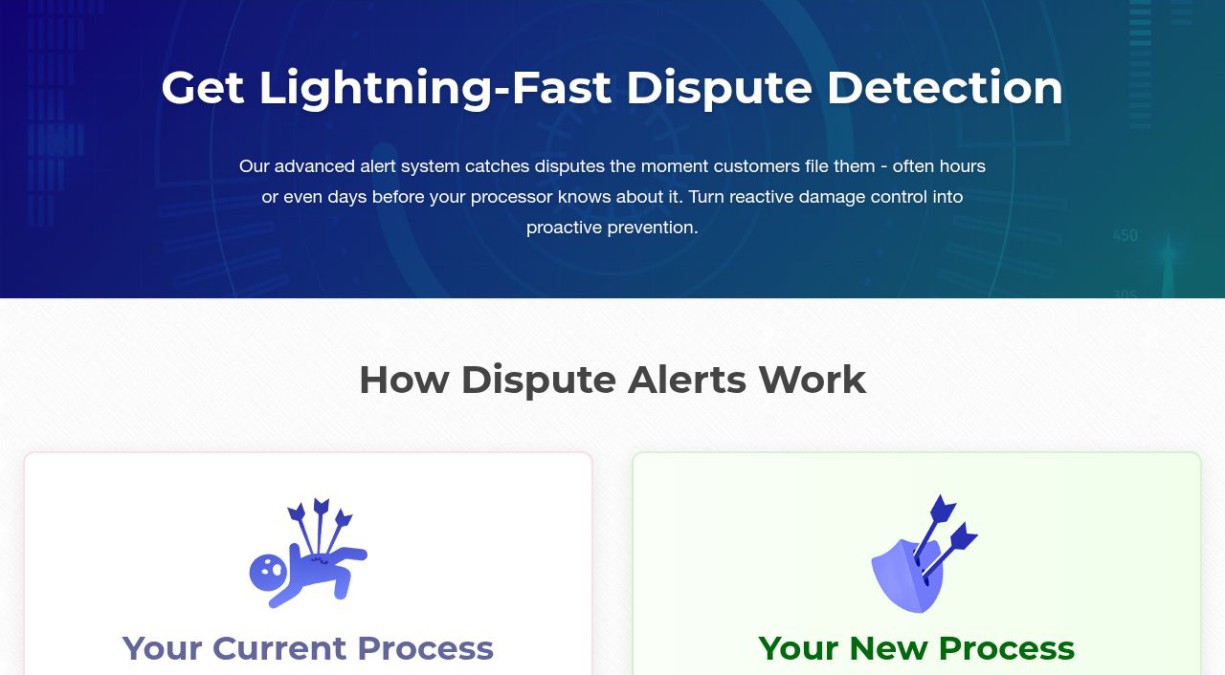What is a Chargeback Alert?
A chargeback alert is an early warning that lets merchants know when a customer starts a dispute. With these alerts merchants can take care of the problem before it turns into a formal chargeback that could hurt their ability to process payments. Most processors will send you these alerts within just a few hours after a customer starts the dispute process – this early heads-up gives merchants a chance to work it out with the customer – maybe through a refund or by fixing whatever problem they have.
You’ll pay processing fees, spend time and money dealing with the paperwork and sometimes even pay penalties to the card networks. What’s worse is that your merchant account could be in danger if you exceed the processor’s chargeback threshold. Banks will start to review your account and might even shut it down if the problem continues.
The big card networks run these alert programs to help merchants save their money and stay in good standing with their payment processors. When you get an alert, you usually have somewhere between 24 and 72 hours to respond (depending on which card network sent it).
How It Works
A chargeback alert arrives when a customer goes to their bank and disputes a charge. These alerts work like an early warning system that lets merchants know before the official chargeback process actually starts. This kind of notification reaches you before any money gets pulled from your account.
When one of these alerts comes in, you’ll get all the information about the transaction that’s being questioned. This includes the order amount, when they bought it, and the reason the customer gave for the dispute. The alert also shows their card information and other transaction data that might help figure out what went wrong and what should happen next.
Timing matters here. Most alert services (like ours) give you somewhere between 24 and 72 hours to respond before the dispute moves forward. That window might not seem like much time, and it honestly isn’t. But it’s actually your best chance to prevent the chargeback completely.
During this response period, there are two main options. You can issue a full refund to fix the customer’s problem, which usually stops the chargeback from happening. Or you can reach out to the customer directly to work through their issue and maybe find a different answer. The choice you make here affects your finances and the customer relationship. Make the wrong choice, and the result is losing the original sale plus paying chargeback fees.
These alerts usually come through email, though several services also let you check a dashboard or connect through API if you want to link them to existing systems. Most merchants find that email alerts work just fine for regular operations, especially when starting out.
You need to treat these alerts like any other business-critical notification. Check email regularly and have a solid plan for who manages disputes when they come in.
How it Affects Chargeback Prevention
When merchants respond to chargeback alerts, they can stop disputes before they turn into chargebacks. This may look like a small detail. But it can make a difference for the chargeback ratio. That ratio is how many chargebacks you get compared to total transactions.
The payment processor keeps a close eye on this number. If it gets too high, you’re going to be in a tough spot. Processors can raise rates or even shut down the account completely. And then you can’t take credit cards at all, which pretty much kills most businesses.
The fees alone are enough to make alerts worth it. Every chargeback costs you the original transaction amount plus fees that can run anywhere from $20 to $100. But when you resolve an alert instead, you usually just refund the customer and move on. No penalty fees to worry about.
Most merchants who respond to alerts end up resolving about 70% of disputes before they become chargebacks. Compare that to trying to fight chargebacks after they happen, where success rates drop down to around 20%.
The relationship with the processor matters more than you might think. Banks and payment companies prefer to work with merchants who have clean chargeback ratios. It shows them that merchants handle customer disputes well and makes them much less risky to work with.
Example Scenarios
When you have chargeback alerts, you find out quickly when a dispute starts. You’ll hear about it in minutes instead of waiting weeks, which gives you plenty of time to refund the customer before it gets worse. The customer gets their money back and your merchant account stays healthy.
Here’s something that happens a lot-say a store ships a product but bad weather slows down the delivery. The upset customer files a chargeback instead of calling the store first. Without alerts, the store won’t know about this for weeks. By then, the package has already shown up and the customer is happy with it.
This bad timing turns solved problems into big costs. Your merchant account takes a hit from disputes that fixed themselves. Plus, you’re stuck paying chargeback fees for packages that customers actually got and kept.
Chargeback alerts fix this whole problem. The store finds out fast and can call the customer to explain what’s going on. Usually they can work it out by sending another package faster, or giving a small discount.
Online sellers run into this all the time. A customer buys software or gets access to an online course, then says their account got hacked. Without alerts, stores lose these disputes and the money. But when they find out early, they can check the account and show proof that helps settle the dispute before it costs them.
Online stores usually have a harder time with these disputes. Customers can say someone stole their info months after they downloaded everything. Your proof that you delivered won’t help much when the chargeback shows up six weeks later.
Requirements and Timeframes
Alert windows are short – most services provide somewhere between 24 to 72 hours to make a choice. That timeline gets even tighter when dealing with multiple alerts at once. Missing that deadline means losing the chance to stop the chargeback from happening.
That’s why teams need someone ready to jump on these alerts the second they come in. Companies could pick specific people to watch for alerts or set up automated systems to manage them. Someone needs to actually see the email in time.
When responses take too long, it costs money. Teams need to know who’s in charge of watching for alerts, and those people need to be able to make decisions immediately.
Before alerts start coming in, it helps to work out basic guidelines for when refunds make sense and when to investigate more. Companies might always refund orders under $50 but review the bigger ones first.
Make sure the alert system connects with the order system. Without this link, teams have to waste time just trying to find order information. Those manual searches eat up response time, and every minute matters when racing against the clock.
Each alert network has its own setup process. Some get companies going in a few days, while others take weeks.
Frequently Asked Questions
How much do chargeback alerts cost?
Chargeback alerts cost money too which needs to go into the budget. Most providers charge a fee for each alert they send, even if a customer gets a refund or the chargeback happens anyway. The fee gets paid whether the alert saves money or not.
The actual cost depends on which provider gets chosen and how many alerts come in each month. Prices range quite a bit from one provider to another. Smaller stores might pay anywhere from $15 to $40 per alert, while bigger businesses can usually negotiate better rates when they process more sales. Some providers give tiered pricing where the per-alert cost goes down as more alerts come in.
Here's where the math gets interesting, though. A single chargeback can cost $100 or more when adding up the chargeback fee, lost product, and all the time staff spends dealing with paperwork. Compare that to paying $25 for an alert that lets the problem get fixed with a quick refund instead. Chargebacks eat into profits fast. Each one takes staff away from other work while they try to pull together all the proof and paperwork needed.
The alert fee looks like an extra expense at first. But it starts to make sense when looking at the bigger picture. It's paying a smaller amount now to prevent losing way more money later. Finance teams will see the difference right away. Most businesses find that even if they only stop half their chargebacks, the alerts still end up paying for themselves.
What's the difference between chargeback alerts and chargeback notifications?
Lots of merchants mix up chargeback alerts and chargeback notifications. They sound similar but work in completely different ways - and most processors don't explain the difference all that well.
These alerts usually come in before a customer files an official chargeback. It's a warning that a problem is coming. This gives merchants time to reach out to the customer directly and work it out. Maybe they'll give them a refund or solve their problem before it turns into something worse.
Merchants save money and customer relationships when they step in early. Customers just want their problem solved - they don't want to go through a long dispute process. When problems get fixed during the alert stage, merchants stay in control of what happens next. How fast they respond can make the difference between keeping that money or losing it.
Notifications are completely different. When one of these shows up, the damage has already started and now it's time to handle it. These come after a chargeback is official and showing up in the account. At that point the options become limited. Merchants can accept the chargeback and lose the money, or fight it through the dispute process.
The timing makes all the difference here. With alerts, it's possible to stop the chargeback from ever happening. With notifications, the goal is trying to limit the damage. A good plan needs to include both tools because they do different jobs when disputes come up.
With alerts, merchants need to respond quickly with strong customer service and quick fixes. With notifications, they need to pull together documents, get all the evidence, and get ready for the dispute process.
Which banks participate in chargeback alert networks?
The truth is that chargeback alerts won't cover every single dispute that comes your way. These numbers are usually pretty similar no matter what industry you're in. The main networks like Ethoca and Verifi each work with different banks, and when you put them together they'll cover about 40% of banks out there. What this tells us is that roughly 60% of chargebacks could still show up without giving you any heads-up at all.
Now this gap in coverage doesn't make alerts useless by any means. What it does mean is that merchants can't count on them as the only way to fight chargebacks. It's better to think of alerts as just one part of a bigger strategy instead of expecting them to solve all chargeback problems on their own.
Even partial protection is still worth having when chargebacks put merchant accounts in danger. Every dispute that gets stopped early saves money on higher processing fees and prevents account restrictions. Your payment processor keeps a close eye on everything here.
If you're trying to get the best coverage possible, it makes sense to look for providers that pull alerts from multiple networks instead of just one. Most providers now have this kind of multi-network setup. Doing this will help stop more disputes before they actually turn into chargebacks, even though nothing catches everything.
After an alert shows up, it needs attention - fast. Most alerts give somewhere between 24 and 72 hours to respond before the dispute automatically turns into a chargeback. Missing that deadline means losing the chance to deal with it quietly.
Response time actually determines if disputes stay under control or turn into chargebacks. Every missed alert turns into a chargeback with fees attached.
 Call (844) NO-DISPUTES
Call (844) NO-DISPUTES



